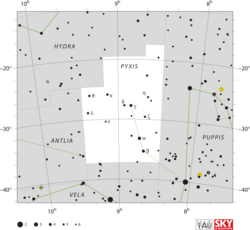Astronomy:Alpha Pyxidis
From HandWiki
Short description: B-type giant star in the constellation Pyxis
| Observation data Equinox J2000.0]] (ICRS) | |
|---|---|
| Constellation | Pyxis |
| Right ascension | 08h 43m 35.53756s[1] |
| Declination | −33° 11′ 10.9898″[1] |
| Apparent magnitude (V) | 3.67[2] |
| Characteristics | |
| Spectral type | B1.5III[3] |
| U−B color index | −0.84[2] |
| B−V color index | −0.19[2] |
| Variable type | Beta Cephei[4] |
| Astrometry | |
| Radial velocity (Rv) | +15.3[5] km/s |
| Proper motion (μ) | RA: −14.27[1] mas/yr Dec.: +10.43[1] mas/yr |
| Parallax (π) | 3.71 ± 0.14[1] mas |
| Distance | 880 ± 30 ly (270 ± 10 pc) |
| Absolute magnitude (MV) | −3.47[6] |
| Details | |
| Mass | 10.7[4] M☉ |
| Radius | 6.3 ± 1.0[7] R☉ |
| Luminosity | 10,000[4] L☉ |
| Surface gravity (log g) | 3.63[8] cgs |
| Temperature | 24,300[8] K |
| Metallicity [Fe/H] | −0.18[8] dex |
| Rotational velocity (v sin i) | 11[9] km/s |
| Other designations | |
| Database references | |
| SIMBAD | data |
Alpha Pyxidis, Latinised from α Pyxidis, is a giant star in the constellation Pyxis. It has a stellar classification of B1.5III and is a Beta Cephei variable. This star has more than ten times the mass of the Sun and is more than six times the Sun's radius. The surface temperature is 24,300 K and the star is about 10,000 times as luminous as the Sun.[3][4][8] Stars such as this with more than 10 solar masses are expected to end their life by exploding as a supernova.[11]
Naming
In Chinese, 天狗 (Tiān Gǒu), meaning Celestial Dog, refers to an asterism consisting of α Pyxidis, e Velorum, f Velorum, β Pyxidis, γ Pyxidis and δ Pyxidis. Consequently, α Pyxidis itself is known as 天狗五 (Tiān Gǒu wǔ, English: the Fifth Star of Celestial Dog).[12]
References
- ↑ 1.0 1.1 1.2 1.3 1.4 van Leeuwen, F. (November 2007), "Validation of the new Hipparcos reduction", Astronomy and Astrophysics 474 (2): 653–664, doi:10.1051/0004-6361:20078357, Bibcode: 2007A&A...474..653V
- ↑ 2.0 2.1 2.2 Fernie, J. D. (May 1983). "New UBVRI photometry for 900 supergiants". Astrophysical Journal Supplement Series 52: 7–22. doi:10.1086/190856. Bibcode: 1983ApJS...52....7F.
- ↑ 3.0 3.1 Hiltner, W. A.; Garrison, R. F.; Schild, R. E. (July 1969). "MK Spectral Types for Bright Southern OB Stars". Astrophysical Journal 157: 313. doi:10.1086/150069. Bibcode: 1969ApJ...157..313H.
- ↑ 4.0 4.1 4.2 4.3 Hubrig, S. et al. (January 2009). "New magnetic field measurements of beta Cephei stars and Slowly Pulsating B stars". Astronomische Nachrichten 330 (4): 317. doi:10.1002/asna.200811187. Bibcode: 2009AN....330..317H.
- ↑ Wilson, R. E. (1953). "General Catalogue of Stellar Radial Velocities". Carnegie Institute Washington D.C. Publication (Carnegie Institute of Washington D.C.). Bibcode: 1953GCRV..C......0W.
- ↑ Anderson, E.; Francis, Ch. (2012), "XHIP: An extended hipparcos compilation", Astronomy Letters 38 (5): 331, doi:10.1134/S1063773712050015, Bibcode: 2012AstL...38..331A.
- ↑ Hubrig, S.; Ilyin, I.; Schöller, M.; Briquet, M.; Morel, T.; De Cat, P. (January 2011), "First Magnetic Field Models for Recently Discovered Magnetic β Cephei and Slowly Pulsating B Stars", The Astrophysical Journal Letters 726 (1): L5, doi:10.1088/2041-8205/726/1/L5, Bibcode: 2011ApJ...726L...5H, http://orbi.ulg.ac.be/bitstream/2268/81132/1/apjl_726_1_5.pdf
- ↑ 8.0 8.1 8.2 8.3 Kilian, J. (February 1994). "Chemical abundances in early B-type stars. 5: Metal abundances and LTE/NLTE comparison". Astronomy and Astrophysics 282 (3): 867–873. Bibcode: 1994A&A...282..867K.
- ↑ Nieva, M. F.; Przybilla, N. (April 2008). "Carbon abundances of early B-type stars in the solar vicinity. Non-LTE line-formation for C II/III/IV and self-consistent atmospheric parameters". Astronomy and Astrophysics 481 (1): 199–216. doi:10.1051/0004-6361:20078203. Bibcode: 2008A&A...481..199N.
- ↑ "alf Pyx". SIMBAD. Centre de données astronomiques de Strasbourg. http://simbad.u-strasbg.fr/simbad/sim-basic?Ident=alf+Pyx.
- ↑ Reed, B. Cameron (June 28, 2005). "New Estimates of the Solar-Neighborhood Massive-Stars Birthrate and the Galactic Supernova Rate". The Astronomical Journal 130 (4): 1652–1657. doi:10.1086/444474. Bibcode: 2005AJ....130.1652R.
- ↑ (in Chinese) AEEA (Activities of Exhibition and Education in Astronomy) 天文教育資訊網 2006 年 7 月 17 日
External links
- Kaler, James. "Alpha Pyxidis". University of Illinois. http://stars.astro.illinois.edu/sow/alphapyx.html. Retrieved 2010-02-23.
 |


